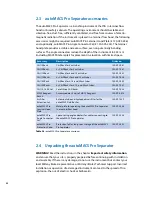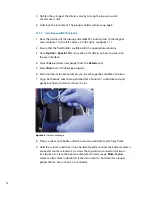
68
the waste bottle, a fluid outlet port. To measure the filling status, bottle closures
also have a sensor for measuring electrolyte conductivity. However, the storage
solution (70% ethanol) does not contain electrolytes. Therefore, the filling status of
the storage solution bottle cannot be measured by the instrument and must be
checked visually. For your convenience, the fluid bottles, bottle closures, and fluid
sensor cables are color-coded.
Bottle
Symbol
Running Buffer (blue)
Washing Solution (green)
Storage Solution (black)
Waste (Red)
Table 2.4: Color-coding of fluid bottles.
1 Install one fluid bottle at a time. Please note the corresponding color-coding
(table 2.4).
2 Take out an empty bottle and unscrew bottle closures counter-clockwise but do
not remove the bottle closures from the bottles. Do not disconnect the color-
coded tubing.
3 Place a fresh bottle into its appropriate holder, open it and fasten the bottle
closure to the new bottle. Note the color-coding and connect each sensor cable
to the respective bottle closure. Note: To avoid contamination and spillover,
do not open a fresh bottle before it is placed in its holder. Before removing a
full waste bottle from the bottle holder, fasten a standard lid onto the bottle to
avoid spillover.
4 Attach the sensor cable plug to the socket labeled Bottle Sensor at the back of
the autoMACS Pro Separator and fasten securely.
5 Attach the sensor cables to the cable guide at the back of the autoMACS Pro
Separator.
6 Connect the hydrophobic air filters (0.2 μm) to the appropriate connectors on
the bottle closures. Note: Avoid any contact of the hydrophobic air filter with
fluids as this may cause clogging of the filter.
















































